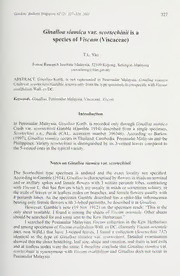
Ginalloa siamica var. scortechinii is a species of Viscum (Viscaceae) PDF
Preview Ginalloa siamica var. scortechinii is a species of Viscum (Viscaceae)
Gardens'BulletinSingapore62 (2): 327-328. 2011 327 Ginalloa siamica var. scortechinii is a species of Viscum (Viscaceae) T.L. Yao Forest Research Institute Malaysia, 52109 Kepong, Selangor, Malaysia [email protected] ABSTRACT. Ginalloa Korth. is not represented in Peninsular Malaysia. Ginalloa siamica Craibvar.scortechiniiGamble,knownonlyfromthetypespecimen, isconspecificwith Viscum ovalifolium Wall, ex DC. Keywords. Ginalloa, Peninsular Malaysia, Viscaceae, Viscum Introduction In Peninsular Malaysia, Ginalloa Korth. is recorded only through Ginalloa siamica Craib var. scortechinii Gamble (Gamble 1914) described from a single specimen, Scortechini s.n., Perak (CAL, accession number 396346). According to Barlow (1997), Ginalloasiamica occurs in Thailand, Cambodia, Peninsular Malaysia and the Philippines. Variety scortechinii is distinguished by its 3-veined leaves compared to the 5-veined ones in the typical variety. Notes on Ginalloa siamica var. scortechinii The Scortechini type specimen is undated and the exact locality not specified. AccordingtoGamble (1914), Ginalloa ischaracterisedbyflowers intriads onterminal and/or axillary spikes and female flowers with 3 minute perianth lobes, contrasting with Viscum L. that has flowers which are usually in triads or sometimes solitary, in the axils of leaves or at leafless nodes on branches, and female flowers usually with 4 perianth lobes. As the specimen Gamble described has a spike-like inflorescence bearing only female flowers with 3-lobed perianths, he described it as Ginalloa. However, Gamble's note (19 Nov 1912) on the specimen reads: "This is the only sheet available. I found it among the sheets of Viscum orientale. Other sheets should be searched for and some sent to the Kew Herbarium." I searched the Peninsular Malaysian Viscum collection in the Kew Herbarium and among specimens of Viscum ovalifolium Wall, ex DC. (formerly Viscum orientale auct. non Willd.) that have 3-veined leaves, I found a collection {Scortechini 732) identical to the type of Ginalloa siamica var. scortechinii. Detailed examination showed that the shoot branching, leafsize, shape and venation, and fruits in leafaxils and at leafless nodes were the same. I therefore conclude that Ginalloa siamica var. scortechinii is synonymous with Viscum ovalifolium and Ginalloa does not occur in Peninsular Malaysia. 328 Curd Bull. Singapore62(2)2011 Barlow (1997) noted that Viscum ovalifolium is polymorphic, and that while its flowers are usuallyarranged in triads or sometimes solitary, theyare less usually found along leafless shoots that superficially resemble the spicate inflorescences ofGinalloa. This is well illustrated by the collection Chew et al. FRI 53735 (KEP). Also, it is not uncommon for female flowers to have a perianth lobe missing, i.e. with only three lobes present. Danser (1931) had maintained Ginalloa siamica var. scortechinii but Barlow (1997) did not recognise the variety, although the latterstill regarded Ginalloa siamica as having a distribution that extended into Peninsular Malaysia. Neither had seen the type (Barlow,pers. com.). Viscum ovalifolium Wall, ex DC. Prodr. (DC.) 4: 278 (1830). TYPE: Wallich 489, Penang (holofype K-W). Ginalloa siamica Craib var. scortechinii Gamble, J. Asiat. Soc. Bengal 75: 383 (1914), syn. nov. TYPE: Scoriechinis.n., Perak. PeninsularMalaysia (holotypeCAL, accession number 396346). ACKNOWLEDGEMENTS. I am deeply indebted to M.S. Mondal from the Botanical Survey of India. Central National Herbarium (CAL) for providing the image ofthe specimen. I am grateful to the curators ofthe herbaria ofthe Royal Botanic Gardens. Kew (K). Nederlands Centre for BiodiversityNaturalis (sectionNationaal Herbarium Nederland). Leiden University (L),and Singapore BotanicGardens(SING) forpermission toexaminespecimens in theircare. The MinistryofScience.Technologyand InnovationofMalaysiaisacknowledged forfinancial support for the Flora ofPeninsular Malaysia Project (No. 01-04-01-000 Khas 2) under which thisstudywascarriedout. I amgrateful to L.G. Saw. R.C.K. Chungand R. Kiew foradviceand comments in improvingthemanuscript.Also. I would liketoexpressmygratitudetooneofthe reviewers who took time to do a careful editing in helping me to shorten the text. References Barlow, B.A. (1997) Viscaceae. Fl. Malesiana, Ser. /, 13: 403^142. Candolle, A.P. De (1830) Prodromus systematis naturalis regni vegetabilis 4. Paris: & Treuttel Wiirtz. Danser, B.H. (1931) The Loranthaceae of the Netherlands Indies. Bull. Jard. Bot. Buitenzorg111, 11: 233-519. Gamble, J.S. (1914) Loranthaceae. Flora of the Malayan Peninsula. J. Asiat. Soc. Bengal 75: 349-391.
